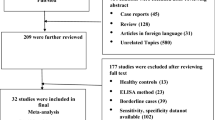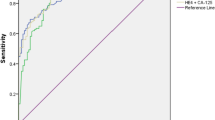Abstract
Epithelial ovarian cancer accounts for more than 90% of ovarian tumours and continues as a leading cause of death from gynaecological malignancies. It is often difficult to differentiate a benign ovarian mass from malignant ones. Invasive histopathological biopsy is used as the gold standard diagnostic tool to diagnose cancer in patients with ovarian mass. A wide spectrum of Biomarkers were tried in various studies to develop a non invasive diagnostic tool, out of which HE4 and CA 125 remain the only clinically useful biomarker. Consequently various Biomarker based algorithms i.e. Risk of Malignancy Index, risk of ovarian cancer algorithm, OVA1, risk of malignancy algorithm were generated that have been developed to assess the risk of a mass being malignant. These algorithms help in timely triage of patients. Recently in 2016 FDA cleared Ova1 test (OVERA) with CA 125-II, HE4, apolipoprotein A-1, FSH, and transferring (Sensitivity 91% and Specificity 69%) as a referral or Triage test in patients presenting with ovarian mass. Combination of protein and circulating Micro RNA analysis in blood, could provide a comprehensive screening and diagnostic panel, in management of patients presenting with ovarian mass in one clinical setting.

Similar content being viewed by others
References
Siegel RL, Miller KD, Jemal A. Cancer statistics, 2018. CA Cancer J Clin. 2018;68(1):7–30. https://doi.org/10.3322/caac.21442 Epub 2018 Jan 4.
Martina M, Elisa D, Orazio R, Valentina B, Teresita N, Matte G, et al. The ROMA (Risk of ovarian Malignancy algorithm) for estimating the risk of epithelial ovarian cancer in women presenting with pelvic mass: is it really useful? Clin Chem Lab Med. 2011;49(3):521–5.
Perez LFR, Chedraui P, Troyano LJM. Peri and post- menopausal incidental adnexal masses and the risk of sporadic ovarian malignancy, new insight and clinical management. Gynecol Endocrinol. 2010;26:631–43.
Robert CBJ, Steven S, Anna L, Richard GM. Differential diagnosis of a pelvic mass: improved algorithms and novel biomarkers. Int J Gynecol Cancer. 2012;22(1):S5–8.
Nolen B, Velikokhatnaya L, Marrangoni A, De Geest K, Lomakin A, Bast RC Jr, et al. Serum biomarker panel for the determination of Benign from malignant cases in patients with an adnexal mass. Gynecol Oncol. 2010;117(3):440–5.
Van GT, Cadron I, Despierre E, Daemen A, Leunen K, Amant F, et al. HE4 and CA 125 as a diagnostic test in ovarian cancer: prospective validation of the Risk of ovarian Malignancy algorithm. Br J Cancer. 2011;104(5):863–70.
Kim YM, Whang DH, Park J, Kim SH, Lee SW, Park HA, et al. Evaluation of the accuracy of human epididymis protein 4(HE4) in combination with CA 125 for detecting ovarian cancer-a prospective case control study in a Korean population. Clin Chem Med. 2011;49(3):527–34.
Bandiera E, Romani C, Specchia C, Zanoti L, Galli C, Ruggeri G, et al. Serum human epididymis protein 4(HE4) and risk of ovarian malignancy algorithm (ROMA) as new diagnostic and prognostic tool for epithelial ovarian cancer management. Cancer Epidemiol Biomark Prev. 2011;20(12):2496–506.
Su F, Kozak KR, Imaizumi S, Satoshi I, Gaoa F, Malaika WA, et al. Apolipoprotein A-I (apoA-I) and apoA-I mimetic peptides inhibit tumor development in a mouse model of ovarian cancer. Proc Nat Acad Sci USA. 2010;107(46):19997–20002. https://doi.org/10.1073/pnas.1009010107.
Takaishi S, Wang TC. Gene expression profiling in a mouse model of helicobacter-induced gastric cancer. Cancer Sci. 2007;98:284–93.
Nosov V, Su F, Amneus M, Birrer M, Robins T, Kotlerman J, et al. Validation of serum biomarkers for detection of early stage ovarian cancer. Am J Obstet Gynecol. 2009;200(6):639.e1–5. https://doi.org/10.1016/j.ajog.2008.12.042 Epub 2009 Mar 14.
Tuft SH, Nymoen DA, TE Hetland F, Kaern J, Trope CG, Davidson B. APOA1 mRNA expression in ovarian serous carcinoma effusions is a marker of longer survival. Am J Clin Pathol. 2014;142(1):51–7.
Moore RG, Brown AK, Miller MC, Skates S, Allard WJ, Verch T, et al. The use of multiple novel tumour biomarkers for the detection of ovarian cancer in patients with a pelvic mass. Gynecol Oncol. 2008;108(2):402–8.
Zhang B, Barekati Z, Kohler C. Proteomics and biomarkers for ovarian cancer diagnosis. Ann Clin Lab Sci. 2010;40:218–25.
Frederick RU. A perspective on ovarian cancer biomarkers: past, present and yet-to-come. Diagnostics (Basel). 2017;7(1):14. https://doi.org/10.3390/diagnostics7010014.
Moore RG, Miller MC, Disilvestro P, Landrum LM, Gajewski W, Ball JJ, et al. Evaluation of the diagnostic accuracy of the risk of ovarian malignancy algorithm in women with a pelvic mass. Obstet Gynecol. 2011;118(2 Pt 1):280–8. https://doi.org/10.1097/AOG.0b013e318224fce2.
Macuks R, Baidekalna I, Gritcina J, Avdejeva A, Donina S. Apolipoprotein A1 and transferrin as biomarker in ovarian cancer diagnostics. Acta Chirurgica Latviensis. 2010;10(2):16–20. https://doi.org/10.2478/v10163-011-0003-3.
Brian MN, Anna EL. Biomarker testing for ovarian cancer: clinical utility of multiplex assays. Mol Diagn Ther. 2013;17(3):139–46. https://doi.org/10.1007/s40291-013-0027-6.
Yang WL, Zhen L, Robert CB. The role of biomarkers in the management of epithelial ovarian cancer. Expert Rev Mol Diagn. 2017;17(6):577–91.
Meredith CH, Michael S, Sherri B, Quynh T, Elias L, Malpuri R, et al. A combinatorial proteomic biomarker assay to detect ovarian cancer in women. Biomark Cancer. 2018;10:1–16. https://doi.org/10.1177/1179299X18756646.
Meenal R, Sameer G, Manisha S. Biomarkers towards ovarian cancer diagnostics: present and future prospects. Braz Arch Biol Technol. 2016;59:1–15. https://doi.org/10.1590/1678-4324-2016160070.
Ann RH, Gunnar K, Andy E, Cybil A, Maria PBG, Philip B, et al. Evaluation of prognostic and predictive significance of circulating micrornas in ovarian cancer patients. Dis Mark. 2017;3:1–9. https://doi.org/10.1155/2017/3098542.
Hentze JL, Hogdall C, Kjaer SK, Blaakaer J, Hogdall E. Searching for new biomarkers in ovarian cancer patients: rationale and design of a retrospective study under the Mermaid III project. Contemp Clin Trials Commun. 2017;13(8):167–74. https://doi.org/10.1016/j.conctc.2017.10.003 Ecollection 2017 Dec.
Marta L, Rui P, Susanne B, Ulla E, Sonja G, Christina B. Platelet protein biomarker panel for ovarian cancer diagnosis. Biomark Res. 2018;6:2. https://doi.org/10.1186/s40364-018-0118-y.
Karen HL. Screening for ovarian cancer in asymptomatic women. JAMA. 2018;319(6):557–8. https://doi.org/10.1001/jama.2017.21894.
Cohen JD, Li L, Wang Y, Thoburn C, Afsari B, Danilova L, et al. Detection and localization of surgically resectable cancers with a multi-analyte blood test. Science. 2018;359(6378):926–30. https://doi.org/10.1126/science.aar3247 Epub 2018 Jan 18.
Henderson JT, Webber EM, Sawaya GF. Screening for ovarian cancer: updated evidence report and systematic review for the us preventive services task force. JAMA. 2018;319(6):595–606. https://doi.org/10.1001/jama.2017.21421.
Montagnana M, Benati M, Danese E. Circulating biomarkers in epithelial ovarian cancer diagnosis: from present to future perspective. Ann Transl Med. 2017;5(13):276. https://doi.org/10.21037/atm.2017.05.13.
Pendlebury A, Hannan NJ, Binder N, Beard S, Mcgauran M, Grant P, et al. The circulating microRNA-200 family in whole blood are potential biomarkers for high-grade serous epithelial ovarian cancer. Biomed Rep. 2017;6(3):319–22. https://doi.org/10.3892/br.2017.847 Epub 2017 Jan 25.
Kafshdooz L, Pourfathi H, Akbarzadeh A, Kafshdooz T, Razban Z, Sheervalilou R, et al. The role of microRNAs and nanoparticles in ovarian cancer: a review. Artif Cells Nanomed Biotechnol. 2018;23:1–7. https://doi.org/10.1080/21691401.2018.1454931 [Epub ahead of print] PMID: 29569937.
Author information
Authors and Affiliations
Corresponding author
Ethics declarations
Conflict of interest
Author declares that they have no conflict of interest.
Ethical Approval
This article does not contain any studies with human participants or animals performed by the authors.
Human and Animal Right Statement
For this type of study formal consent is not required. This article does not contain any studies with human participants or animals performed by the authors.
Rights and permissions
About this article
Cite this article
Kumari, S. Serum Biomarker Based Algorithms in Diagnosis of Ovarian Cancer: A Review. Ind J Clin Biochem 33, 382–386 (2018). https://doi.org/10.1007/s12291-018-0786-2
Received:
Accepted:
Published:
Issue Date:
DOI: https://doi.org/10.1007/s12291-018-0786-2




